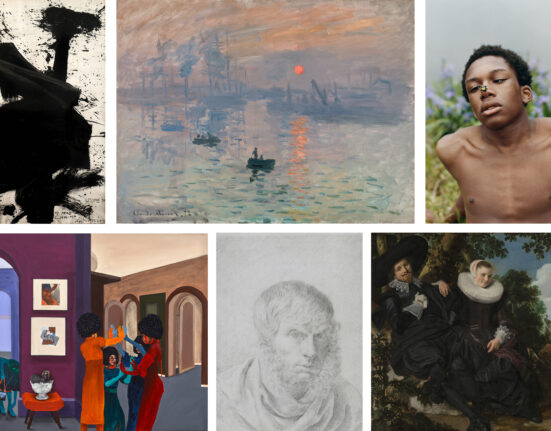On View
The Metropolitan Museum Of Art
Look Again: European Paintings 1300–1800
November 20, 2023 – Ongoing
New York
Like many grand, older museums, the Metropolitan Museum of Art has recently undergone a great revision and expansion of its collection. When it was founded in 1870, the Met was predominantly a Eurocentric institution, though it now has substantial holdings of African, Asian, Oceanic, and Islamic art, as well as galleries devoted to photography, modernism, and contemporary work. Still, when you enter the main entrance and ascend the central stairs into the oldest galleries, you traditionally have been presented with the Old Master European paintings. Now, however, at the top of the stairs, in Gallery 600, a Buddhist sculpture, along with Egyptian, Mexican, and Roman works accompany the three familiar Tiepolo paintings. Muhammad al-Idrisi’s map of the world, situating Europe in a global context, ca. 1154, is reproduced on the wall, accompanied by reproductions of two other maps offering very different perspectives. In Look Again: European Paintings 1300–1800 you really have entered a new art world. Instead of thinking of Europe as a self-contained continent, you see it as a porous site, historically open to cultural exchanges with other artistic cultures.
For some time now, historians have been raising questions about European history that transform the practice of art history. Look Again is the Met’s response to these radical, revisionist ways of thinking. Gallery 601, “European Painting: A Starting Point,” includes a number of Renaissance paintings, many with multi-panels along with two twentieth century triptychs, Max Beckmann’s expressionistic The Beginning (1946–49) and Francis Bacon’s Three Studies for Self-Portrait (1979). Moving on to Gallery 606, “Trade and Transformation in Venice” and Gallery 608, “Faith and Love in Venice,” the museum repackages mostly familiar works in new ways, displaying them with updated wall text. Similarly, in Gallery 620, “Italian Baroque: To Destroy Painting” Nicolas Poussin’s famous dismissive put down of Caravaggio, who the artist said had “come into the world to destroy painting,” is used to identify the roomful of Italian Baroque works. Further on, “The Art of Spanish America, 1550–1820” in Gallery 626 introduces works from the colonies of Spain in the New World, such as Mexico and Guatemala. And as their titles indicate, “Class Dynamics” in Gallery 630, and “Tiepolo and Multiracial Europe” in Gallery 643 again repackage works from the Met’s collection to better reveal their political history. Then, in a more dramatic transformation, Kerry James Marshall’s Untitled (Studio) (2014) is shown alongside studio scenes by Henri Matisse and Elaine de Kooning, as well as old master studio scenes. Gallery 619, devoted to El Greco, also includes works by Paul Cézanne and early Pablo Picasso. Salvador Dali’s Crucifixion (Corpus Hypercubus) (1954) is in Gallery 624, hung alongside Spanish old masters. And there are many women added throughout this show, including Lucia Anguissola, Sofonisba Anguissola, Rosalba Carriera, Lavinia Fontana, Marie Guillelmine Benoist, Elaine de Kooning, Charlotte Eustache Sophie de Fuligny Damas, Angelica Kauffmann, Adélaïde Labille-Guiard, Marie Victoire Lemoine, Elisabeth Louise Vigée Le Brun, Judith Leyster, Rachel Ruysch, and Anne Vallayer-Coster.
Replacing traditional chronological and national installations of European art with these novel conceptual frameworks, Look Again offers this radical rehanging as an effective response to what many feminists and other critical scholars have said about how to rewrite European history. That the older masterpieces are included in these new settings is sure to inspire visual reflection, in what appears to be a first draft of what the museum describes as an ongoing project. In response, I have focused on the rooms that offer revisionist commentaries. Now, however, this great beginning of a new curatorial practice deserves to be taken further. Imagine seeing Camille Pissarro’s landscapes next to those of Claude Lorrain, Sean Scully’s cityscapes alongside those of the Dutch masters, or Agnes Martin’s grids next to the golden grids of Giovanni Baronzio’s Scenes from the Life of Christ (second quarter fourteenth century). And, extending that practice, where should the Met’s Cubist paintings be set in relation to old master European art? And how might the museum’s German expressionist paintings be placed here? In exploring answers to these questions, further elective affinities would surely emerge. The possibilities are almost endless.
As it stands, this is an extraordinary curatorial achievement, certain to be widely emulated. Since this presentation in forty-five galleries includes more than seven hundred works, it will take some prolonged leisurely visits to fully judge it. At this difficult political moment, when our shared historical awareness is seemingly precarious, it’s singularly impressive that the Met has undertaken this large-scale, radical rethinking of fundamentals.







